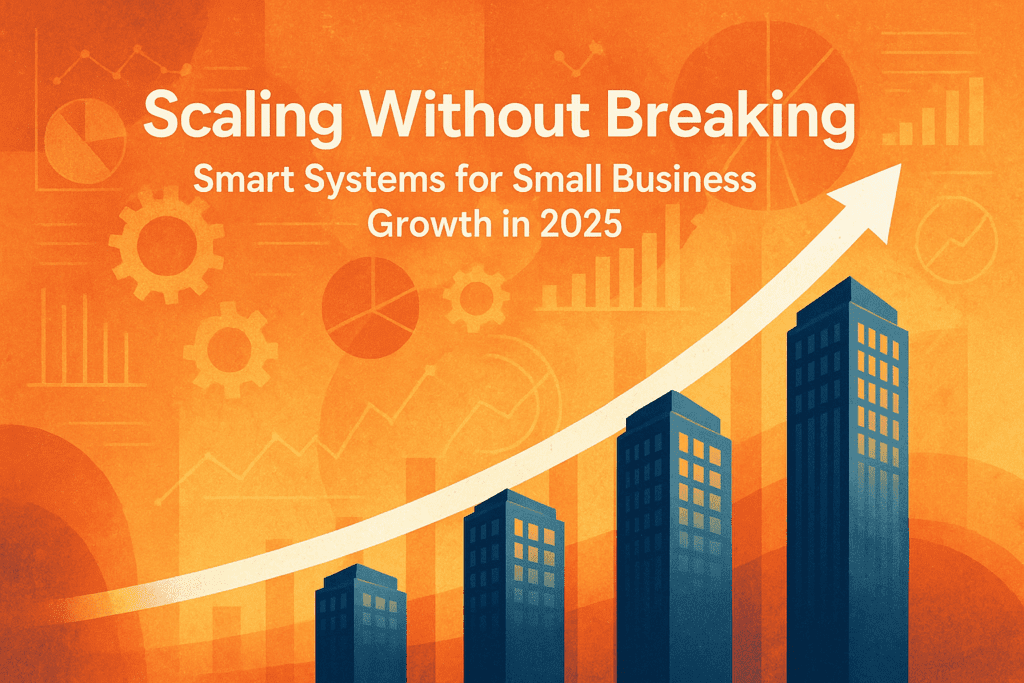
Growth is exciting—but it can also be chaotic. When small businesses start gaining momentum, they often hit bottlenecks that slow them down or stretch their team thin. Without systems in place, scaling can lead to missed opportunities, dropped balls, or burned-out founders. But when your operations are supported by structure, growth becomes sustainable—and even predictable.
Here’s how to scale smart in 2025, without losing control of your time, team, or customer experience.
1. Document and Systemize Your Core Processes
Every recurring task should have a documented process. If it lives only in your head (or one team member’s), you can’t scale it. Documentation allows for delegation, consistency, and faster onboarding.
Action Step: Choose your top three repetitive workflows—like client onboarding, social media posting, or invoicing—and document each step using tools like Notion, ClickUp, or Loom. Keep it simple and visual.
Why It Matters: According to McKinsey, businesses that document workflows improve productivity by up to 30% due to reduced confusion and redundancy.
2. Create a Scalable Client Delivery Framework
When your client experience is inconsistent, retention drops. Building a scalable delivery framework means clients know what to expect—and your team knows exactly how to deliver it.
Action Step: Build a standardized client journey map. Define clear stages (e.g., onboarding → delivery → offboarding) and assign specific tasks and timelines to each. Automate what you can—welcome emails, progress reports, and feedback requests.
Pro Tip: Use a project management tool like Trello or Asana to track each client’s journey and ensure nothing slips through the cracks.
3. Hire for Function, Not Just Fulfillment
Hiring reactively creates disorganization. Instead, identify your business’s bottlenecks and bring in people who can build, not just do. Prioritize hiring for key functions (e.g., marketing ops, sales systems, customer experience) that unlock your next growth phase.
Action Step: Write a job scorecard, not just a description. Define outcomes, not just responsibilities. Look for candidates who have experience scaling teams, not just executing tasks.
Stat to Know: Harvard Business Review reports that 80% of employee turnover is due to bad hiring decisions—usually caused by unclear role definitions.
4. Use Automation to Reduce Low-Leverage Tasks
If you’re doing repetitive work manually, you’re creating unnecessary drag. Automation frees up time for higher-impact work and helps maintain quality at scale.
Action Step: Identify at least three tasks you can automate this month. Examples include:
- Appointment scheduling (Calendly)
- Follow-up emails (ActiveCampaign)
- Lead capture forms (Typeform → Zapier → CRM)
Bonus Tip: Don’t automate too early. Validate the process manually first, then build the automation around it.
5. Measure What Matters and Act on It
Scaling without data is flying blind. You need simple dashboards that track your growth levers—so you know what’s working and what needs fixing.
Action Step: Set up weekly metrics tracking for:
- New leads
- Conversion rates
- Customer lifetime value
- Fulfillment capacity
Use Google Looker Studio or a Notion dashboard to visualize progress and spot trends.
Stat to Know: Businesses that consistently track performance data grow 35% faster on average (Forrester Research).
Scaling a small business doesn’t require hustle overload or hiring a massive team. It requires clarity, systems, and structure. When you streamline your operations, automate the right tasks, and hire for the future—not just today—you create the conditions for steady, scalable success.
Your Move: Pick one bottleneck that’s slowing you down. Document it. Delegate it. Automate it. Every system you build today makes scaling easier tomorrow.


